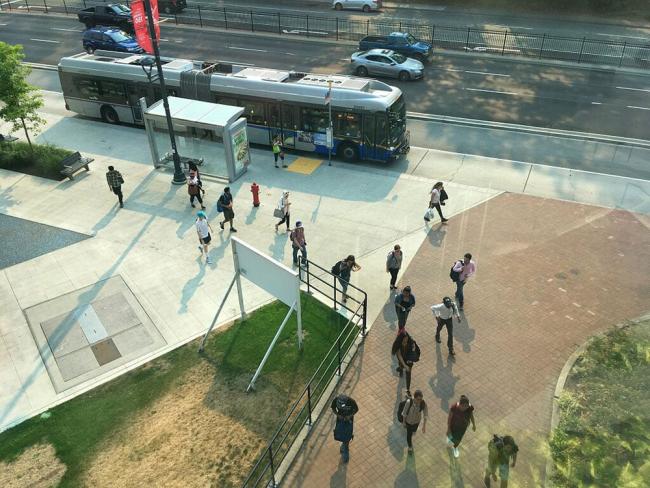Articles Menu

Apr. 22, 2024
Public transportation is woven into the fabric of daily lives for teens. For many, it’s the bridge between home, school and extracurricular activities. What if public transit for youth was a public good? The Transit for Teens campaign aims to make that a reality across British Columbia.
We are members of the Transit for Teens youth leadership coalition with the Centre for Family Equity, and we’re raising awareness in the lead-up to the provincial election this fall about how free transit is a globally tested approach that can meet climate, social inclusion and health goals here in B.C.
We live in regions throughout the province and we’re mobilizing a youth movement to ensure all youth have access to transportation and a sustainable future so they can get to school without barriers every day.
Today, we are calling on the province to extend its Get on Board program to include free transit for everyone up to age 18 in every transit system in B.C.
Youth aged 12 to 18 deserve safe, reliable and accessible transit, too.
The Transit for Teens campaign has been endorsed by over 35 stakeholder groups including the BC School Trustees Association, the BC Teachers’ Federation, the BC Federation of Labour and many school boards, unions and civil society organizations.
According to the Mobility Network at the University of Toronto, each dollar invested in transit returns $5 to $7 in economic and quality of life benefits. Public transit also creates stable, green jobs, and each person that switches from a car to the bus can reduce their annual emissions by 48,000 pounds of carbon dioxide per year. Although personal choices matter, they can take us only so far. To create meaningful change, we need to shift our focus toward reforming public transportation systems and their priorities.
Youth across BC weigh in on transit
Our transit experiences as youth span the province, from the Sunshine Coast to Kelowna to East Vancouver. Harper Stoelting, one of our youth leadership coalition, sees the link between transit and the climate: “We must shift the way our generation looks at and uses transit in order to address the climate crisis here in British Columbia, and lower C02 emissions.”
Ellie Goelman, a 16-year-old coalition member from Vancouver, has been a public transit rider since she was 12. “While I feel fortunate to have had access to transportation, my experiences have been varied. Often buses are overcrowded, unreliable and sparse especially around the edges of the city.” Our movement calls for more investment to support infrastructure investment and expand and strengthen all transit systems in B.C.
Colten Rockford, an engineering student at the University of British Columbia, sees the impact beyond simply making transit free within the system Goelman describes — more riders require better infrastructure to create “a future with better public transit and much more of it.” Mobility is a justice issue — how the system is made private or public, and how it is maintained, offers insights into society’s priorities.
Anjali Varghese, a UBC student and fellow youth leader, sees fare-free transit as an aspect of public health: “[Fare-free transit] ensures that financial constraints do not become barriers to young people’s success and well-being. By removing the cost barrier, we enable teens to attend school regularly, access tutoring, participate in extracurricular activities and access vital resources like food banks without worrying about transportation expenses.”
At-risk youth need transit to ensure safety and security, and to access the resources they need to stabilize their lives. “The cost of transit can be a large burden on youth and their families,” says Cael Read, student trustee for the Sunshine Coast school district. “By investing in fare-free transit we can remove that burden, providing [youth] much-needed relief, while securing the access of all youth to mobility.” Barrier-free access is the ticket to end mobility poverty.
While citizens are balancing the high cost of living and mobility, the lack of a provincial plan forces local communities to juggle questions of access — should fares be lowered, or a bus route expanded? These catch-22s trap local decision-makers, forcing them to choose between offering communities physical or financial access to transportation. These are not “trade-offs,” especially in the context of expanding highways — they are clear indicators of political priorities.
Incentive programs for electric cars are a sign of progress, but they have their own drawbacks. They’re expensive to purchase and maintain, require charging stations that often use electricity from fossil fuels, and create more production and manufacturing emissions than conventional vehicles; and there are currently zero conflict-free methods of mineral extraction for batteries.
When the lens is broadened from the individual to the public — not only in this province, but nationally and globally — investment in public transit takes the burden off individual consumers. Free transit means more than convenience — it’s about reducing car dependency and lessening environmental impact.
“By removing the financial barrier to accessing transit,” says Varghese, “we incentivize more people, including teens, to opt for public transportation for their daily commutes, school trips and other activities.”
The Transit for Teens campaign isn’t just about buses. It’s about altering the trajectory of incentives and priorities to invest in a sustainable future. “This is a doable thing. It just takes a yes,” says Rockford. “So, let’s make this happen.”
The call to action is clear. Let’s build a legacy that makes the world healthier and more accessible for each generation to come with the Transit for Teens solution. Our future depends on it.
Members of the Transit for Teens youth leadership coalition who contributed to this article include Anjali Varghese, Cael Read, Colten Rockford, Ellie Goelman and Harper Stoelting.
Transit for Teens is an initiative of the Centre for Family Equity.
[Top photo: BC’s Get on Board program made public transit free for youth up to 12 across the province. But what about teens? Photo by waferboard via Flickr, Creative Commons licensed.]